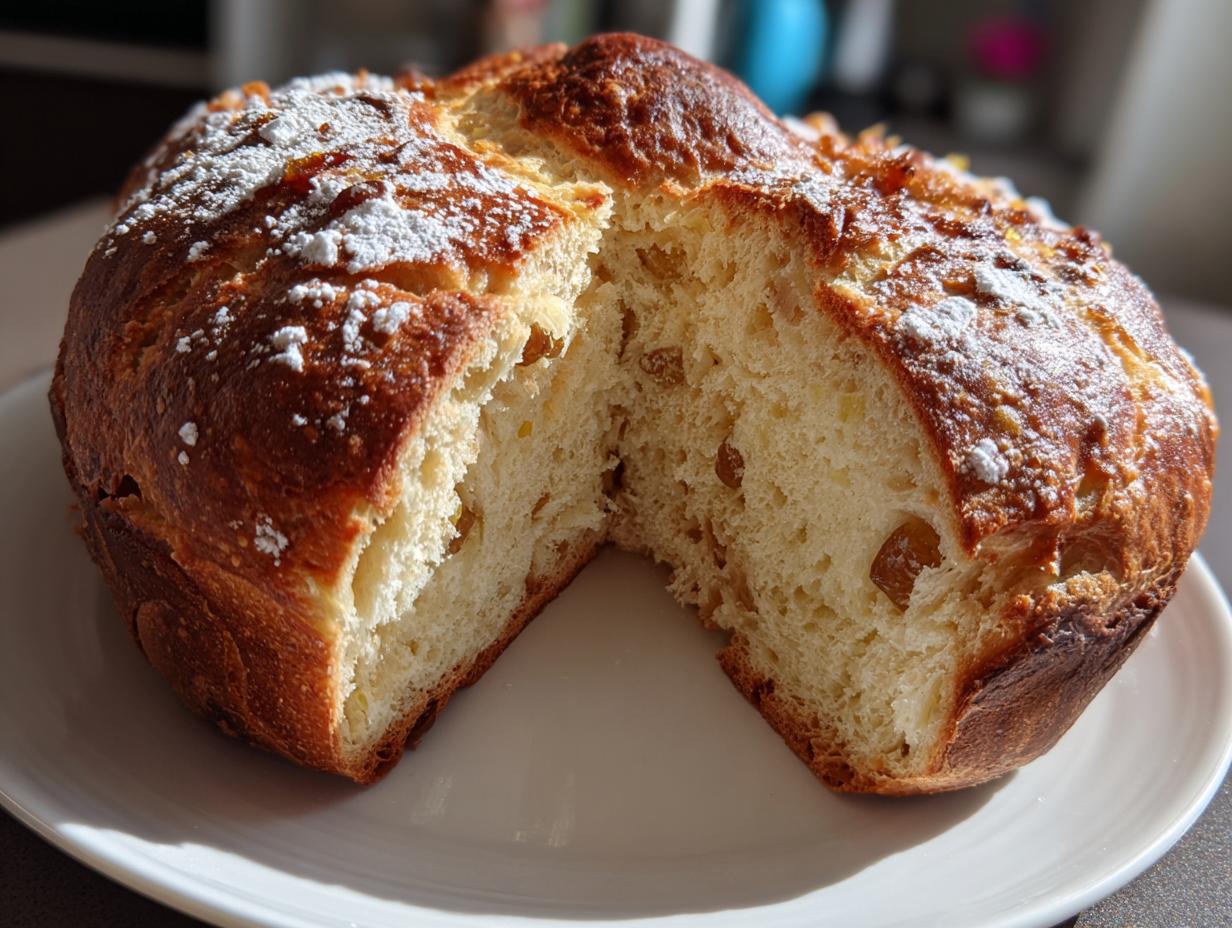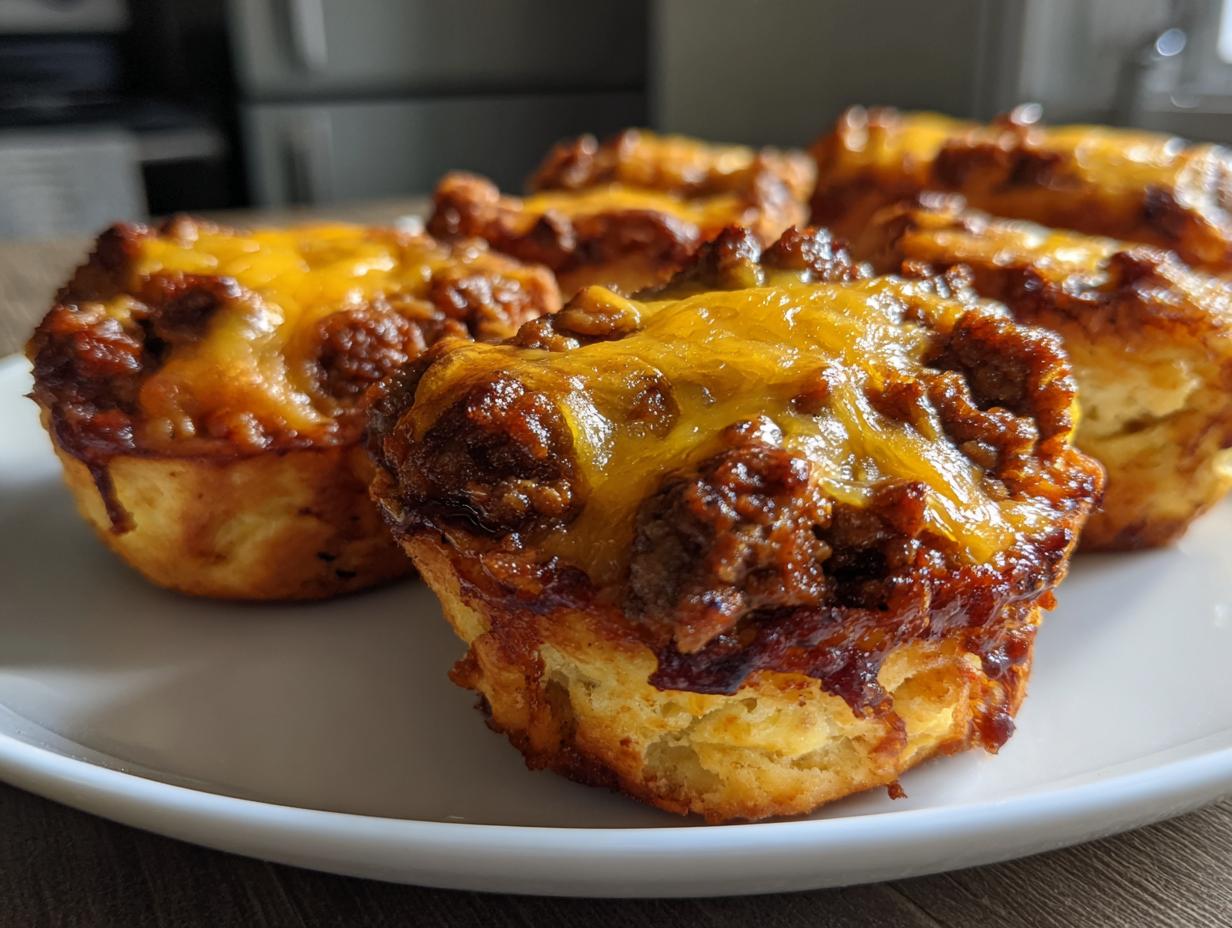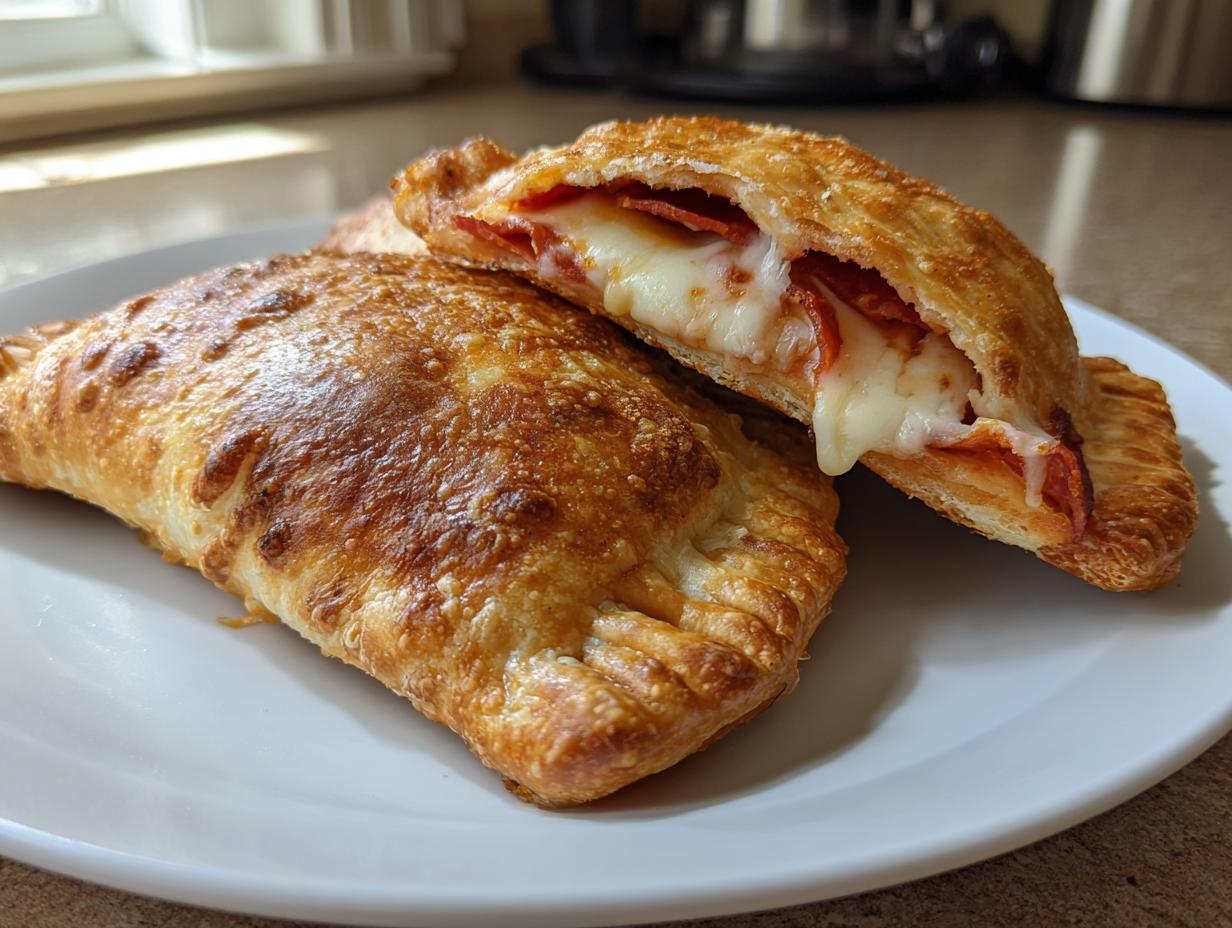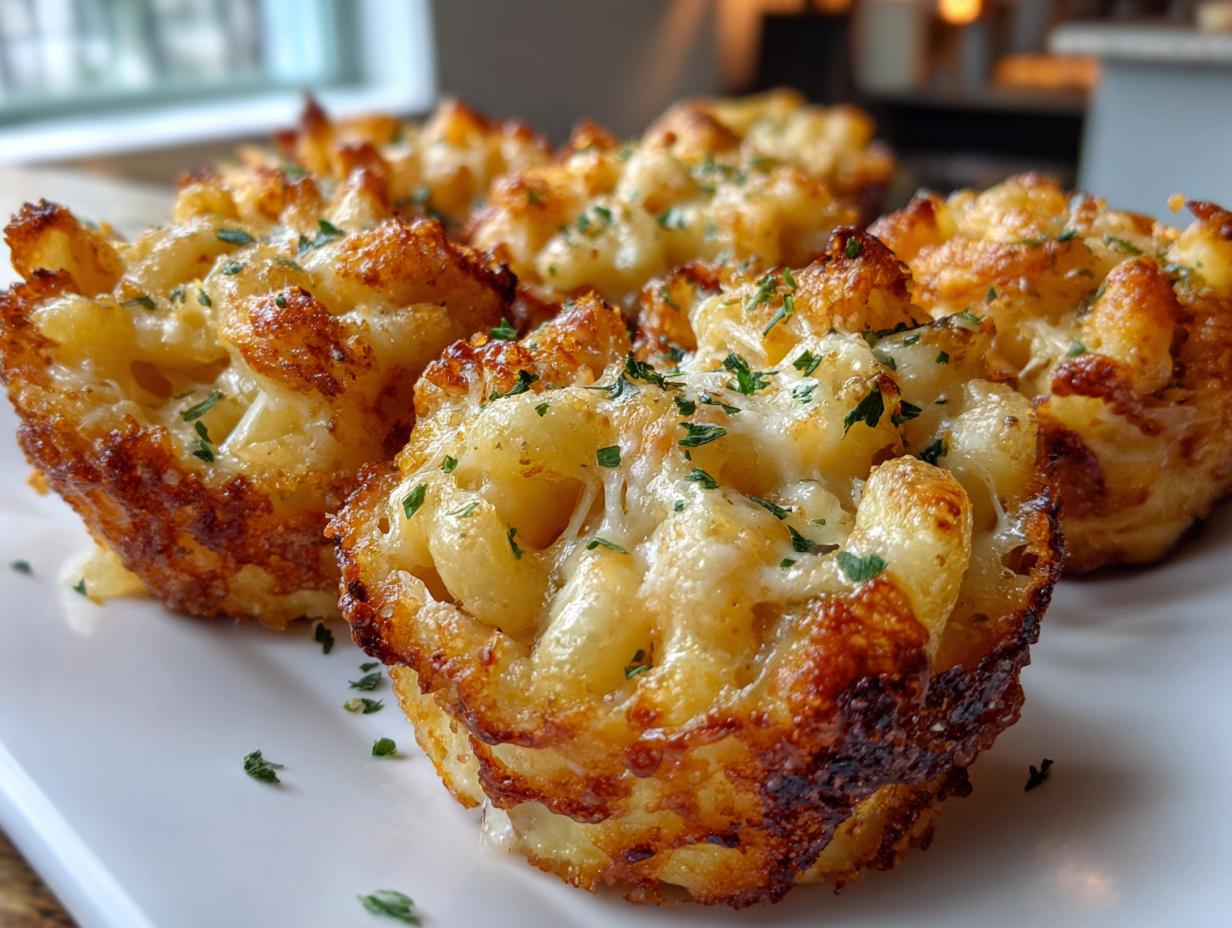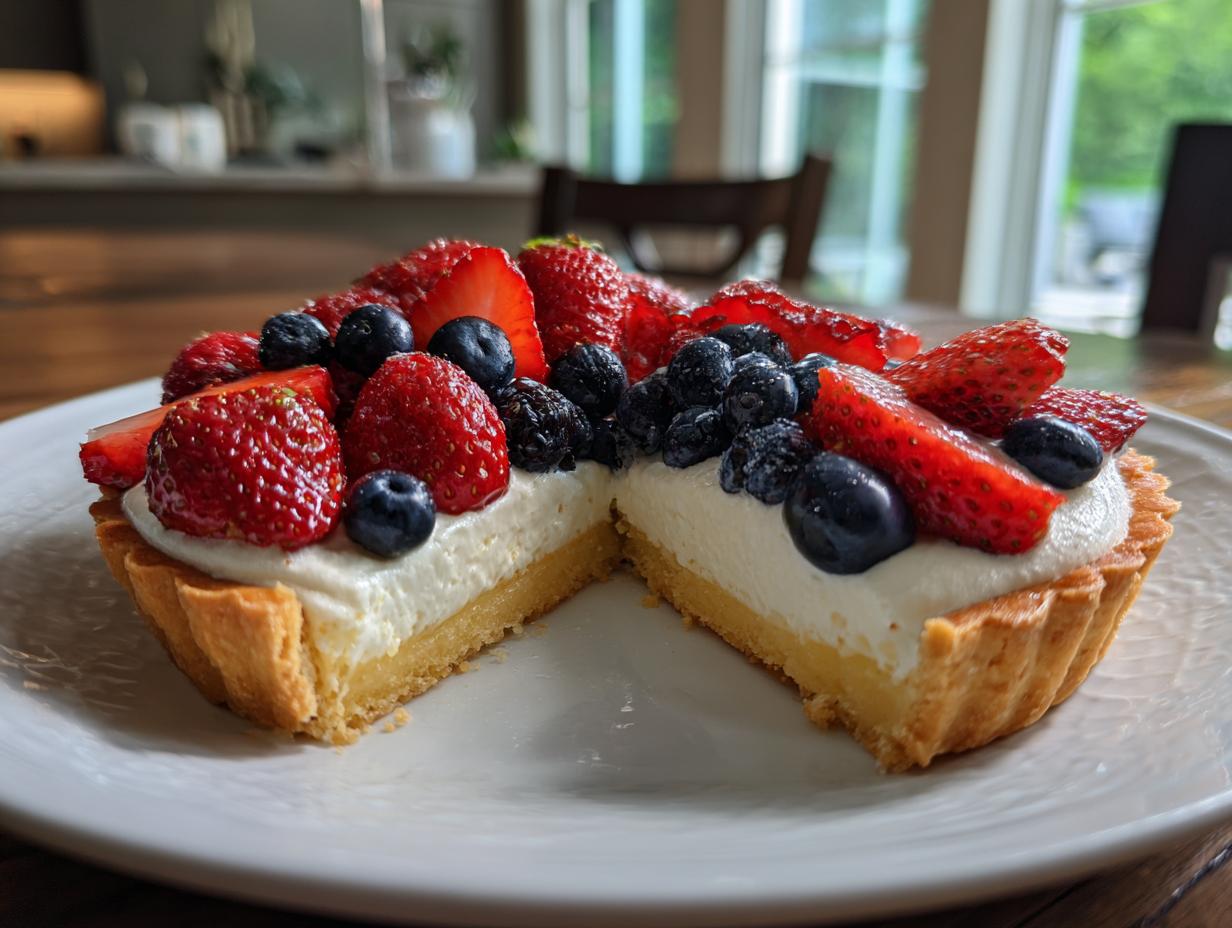There’s something magical about Easter morning in a Ukrainian home—the scent of citrus and yeast filling the air, the table set with embroidered linens, and at the center of it all, a golden, fragrant Stunning Ukrainian Paska Easter Bread. I remember my baba (grandmother) pulling hers from the oven, the crust gleaming under a drizzle of icing, the raisins plump from soaking. It wasn’t just bread; it was a celebration—a symbol of renewal, shared with family after the long Lenten fast.
This recipe is my love letter to those memories. Paska isn’t your everyday loaf—it’s rich with butter, perfumed with lemon and orange zest, and studded with raisins that burst like little pockets of sweetness. The dough is tender yet sturdy enough to hold intricate crosses or braids, a tradition that turns baking into artistry. Whether you’re honoring heritage or starting a new one, this bread is a showstopper that tastes as joyful as it looks. Trust me, one slice of this lightly spiced, slightly sweet masterpiece, and you’ll understand why it’s the crown jewel of the Easter table.
Why You’ll Love This Stunning Ukrainian Paska Easter Bread
This isn’t just bread—it’s a celebration in loaf form! Here’s why it’ll become your new Easter tradition:
- The flavor: Imagine biting into a cloud of sweet, citrus-kissed dough with buttery richness and pops of juicy raisins. It’s like brioche’s more festive cousin.
- The aroma: Your kitchen will smell like a Ukrainian bakery—warm yeast, caramelized sugar, and bright citrus zest mingling together.
- The wow factor: With its golden crust and intricate decorations, this Paska looks as stunning as it tastes. It’s the centerpiece your holiday table deserves.
- The tradition: Baking Paska connects you to generations of Ukrainian families (mine included!) who’ve shared this bread as a symbol of renewal and togetherness.
- The versatility: Enjoy it plain, toasted with honey, or as the base for next-day French toast—it’s delicious every way.
Once you taste that first slice still warm from the oven, you’ll understand why my family fights over the end pieces!
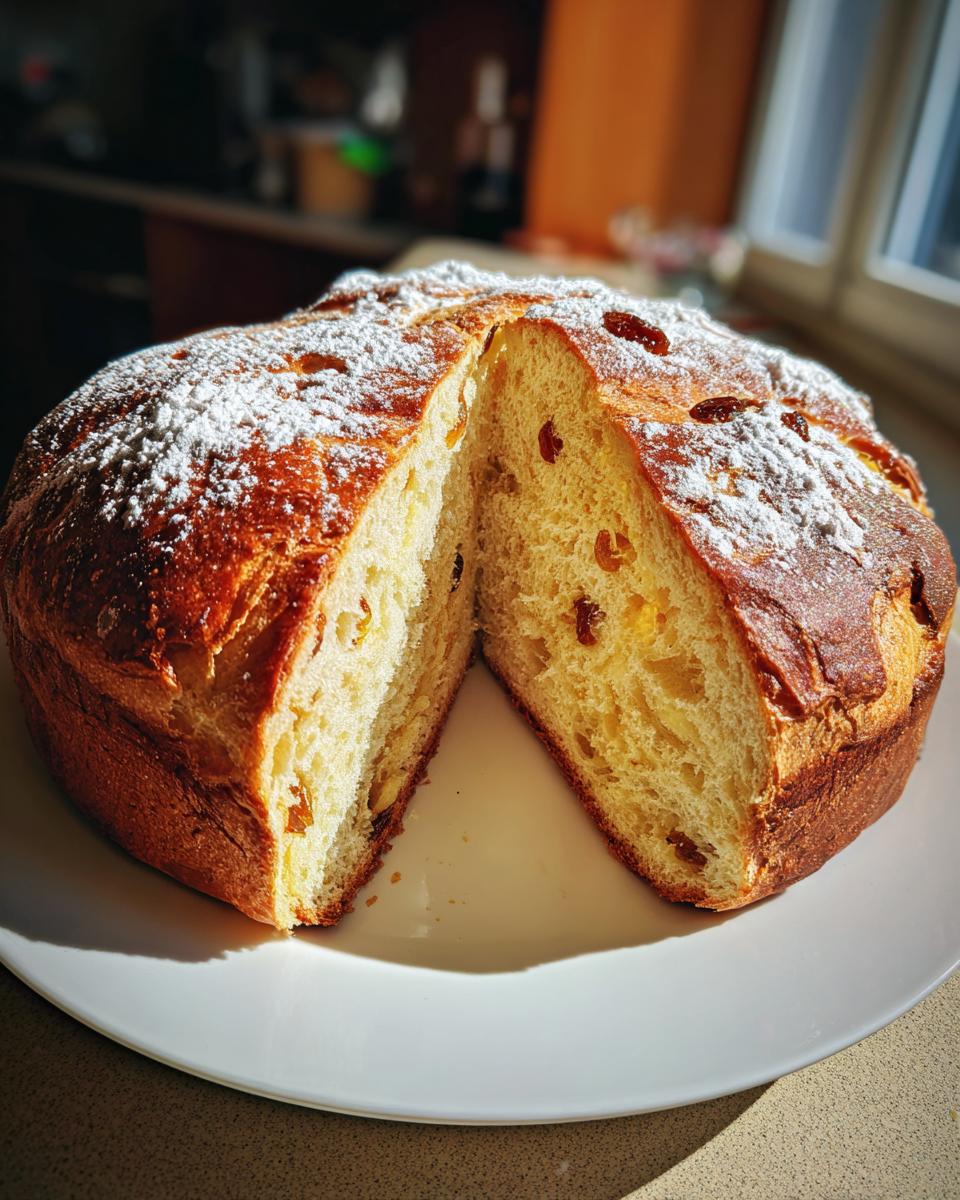
Ingredients for Stunning Ukrainian Paska Easter Bread
Gathering the right ingredients is half the magic! Here’s what you’ll need for that perfect Paska texture and flavor:
- 500g all-purpose flour – Spooned and leveled, not packed (trust me, this matters for the right rise!)
- 100g sugar – Regular granulated works great, but I sometimes sneak in 20g of brown sugar for depth
- 10g active dry yeast – Check the expiration date! Dead yeast means flat Paska
- 250ml warm milk – Just baby-bottle warm (about 110°F/43°C)
- 3 large eggs – Room temperature (leave them out for an hour or float in warm water for 10 minutes)
- 100g unsalted butter – Melted and slightly cooled (I zap it in 15-second bursts to avoid hot spots)
- 1 tsp vanilla extract – The good stuff makes all the difference
- 1 tsp salt – Fine sea salt dissolves best
- 100g raisins – Soak them in warm water (or tea!) for 30 minutes to plump up
- Zest of 1 lemon + 1 orange – Use organic if possible, and zest right before mixing for maximum fragrance
Pro tip: Measure everything before starting—once that yeast gets going, you’ll want to move quickly!
Essential Equipment for Stunning Ukrainian Paska Easter Bread
You don’t need fancy gadgets, but these tools make Paska-baking a breeze:
- Large mixing bowl – Big enough for dough to double in size (I use my grandma’s chipped ceramic one for luck!)
- Stand mixer with dough hook – Or strong arms and a wooden spoon if you’re feeling traditional
- Round 9-inch cake pan – A springform works beautifully for easy release
- Pastry brush – For egg washes that give that golden glow (a folded paper towel works in a pinch)
- Dough scraper – Helps handle sticky dough without over-flouring
Bonus: Keep a clean kitchen towel nearby for covering rising dough—it’s like a cozy blanket for your Paska!
How to Make Stunning Ukrainian Paska Easter Bread
Ready to create some magic? Follow these steps for a Paska that’ll make your baba proud. I’ve included all my little tricks—the ones learned through many Easter seasons and a few happy accidents!
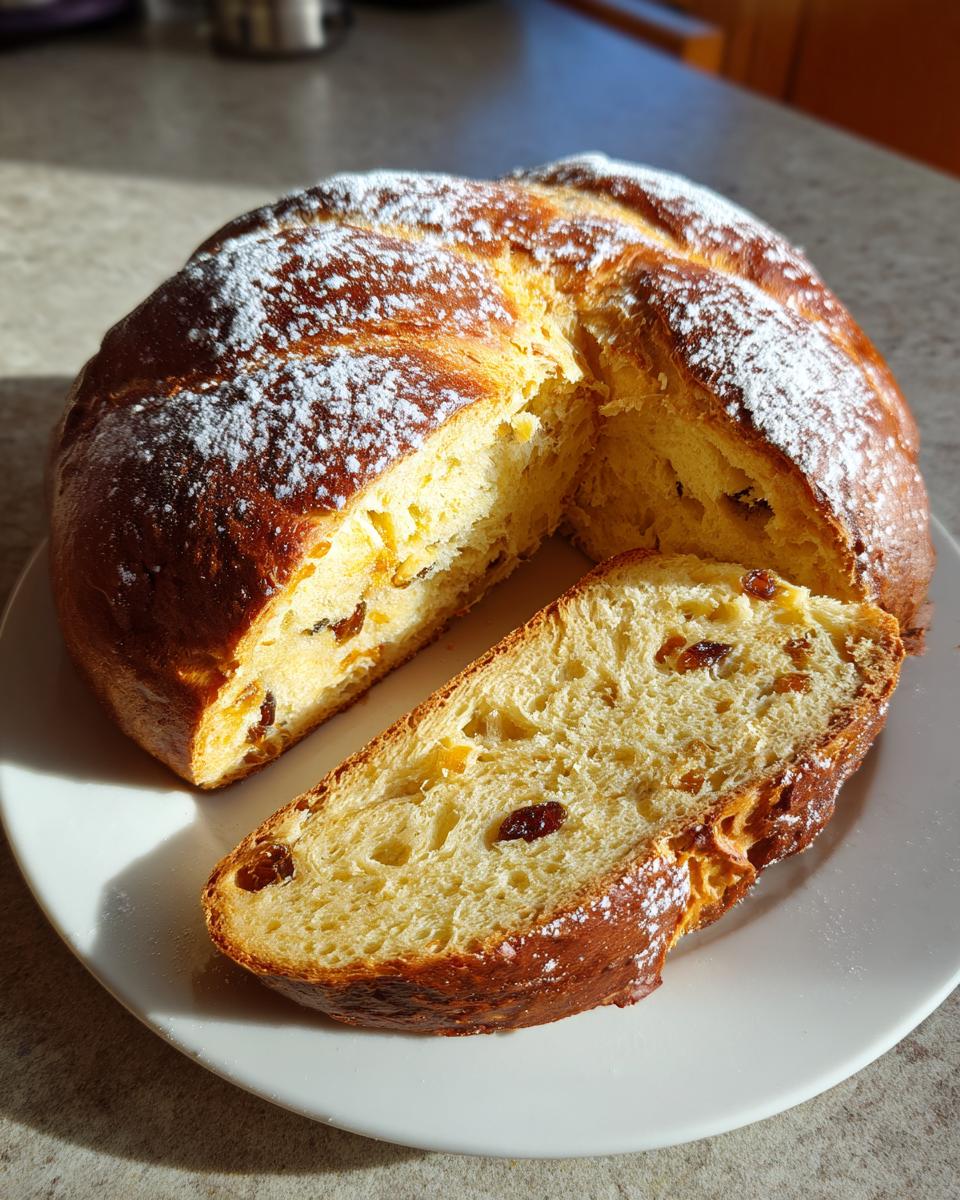
Preparing the Dough
First, wake up that yeast! In a small bowl, mix the warm milk with a pinch of sugar (just a teaspoon from your measured amount) and sprinkle the yeast over it. Let it sit for about 10 minutes—you’ll know it’s ready when it looks foamy like a tiny cappuccino. If it doesn’t bubble, your yeast might be sleepy (or worse, dead), and you’ll need to start fresh.
Meanwhile, whisk together the flour, remaining sugar, and salt in your big mixing bowl. Make a well in the center and pour in the yeast mixture, eggs, melted butter, vanilla, and citrus zest. Now comes the fun part—mixing! Start with a wooden spoon until it gets too sticky, then turn it out onto a lightly floured surface. Knead for about 8-10 minutes (or 5-6 minutes with a dough hook) until the dough is smooth, elastic, and just slightly tacky—like a baby’s cheek. Fold in those plump raisins last so they don’t get smashed.
First Rise and Shaping
Place your beautiful dough ball back in the greased bowl, cover it with that cozy kitchen towel I mentioned earlier, and let it rise in a warm, draft-free spot. This is where patience pays off! It should double in size, which takes about 1.5-2 hours depending on your kitchen’s temperature. My trick? I sometimes let it rise in the oven with just the light on for gentle warmth.
Once it’s puffy and glorious, punch it down (so satisfying!) and turn it out onto your work surface. Shape it into a smooth round—think “perfectly inflated basketball”—and place it in your greased pan. Cover again and let it rise for another hour until it’s just peeking over the pan’s edge. This second rise is shorter but just as important for that light texture.
Baking the Paska
Preheat your oven to 350°F (180°C) about 20 minutes before baking. If you want extra shine, brush the top with an egg wash (1 egg beaten with 1 tbsp water). Bake for 40-45 minutes—you’ll know it’s done when the top is deep golden brown (like a perfect suntan), and it sounds hollow when tapped on the bottom. If it’s browning too fast, tent it with foil after 30 minutes.
Resist the urge to slice immediately! Let it cool in the pan for 10 minutes, then transfer to a wire rack. The wait is torture, but cutting too soon makes it gummy. Trust me—I’ve learned this the hard way!
Tips for Perfect Stunning Ukrainian Paska Easter Bread
After years of Paska trials (and a few hilarious failures), here are my foolproof secrets for bakery-worthy results:
- Yeast check: Always test yeast in warm milk with sugar first—if it doesn’t foam within 10 minutes, toss it and start fresh. I keep an extra packet in the fridge just in case!
- Kneading sweet spot: Stop when the dough springs back slowly when poked—over-kneading makes it tough, under-kneading leaves it dense.
- Rise right: Find the warmest spot in your kitchen (near the stove or in the oven with just the light on). Cold dough takes forever to rise.
- Raid the raisins: Pat them dry after soaking so they don’t make the dough soggy. I sometimes toss them with a spoon of flour to prevent sinking.
- Oven watch: Rotate the pan halfway for even browning—every oven has hot spots!
Remember: Paska isn’t fussy, it just likes attention—like a good friend!
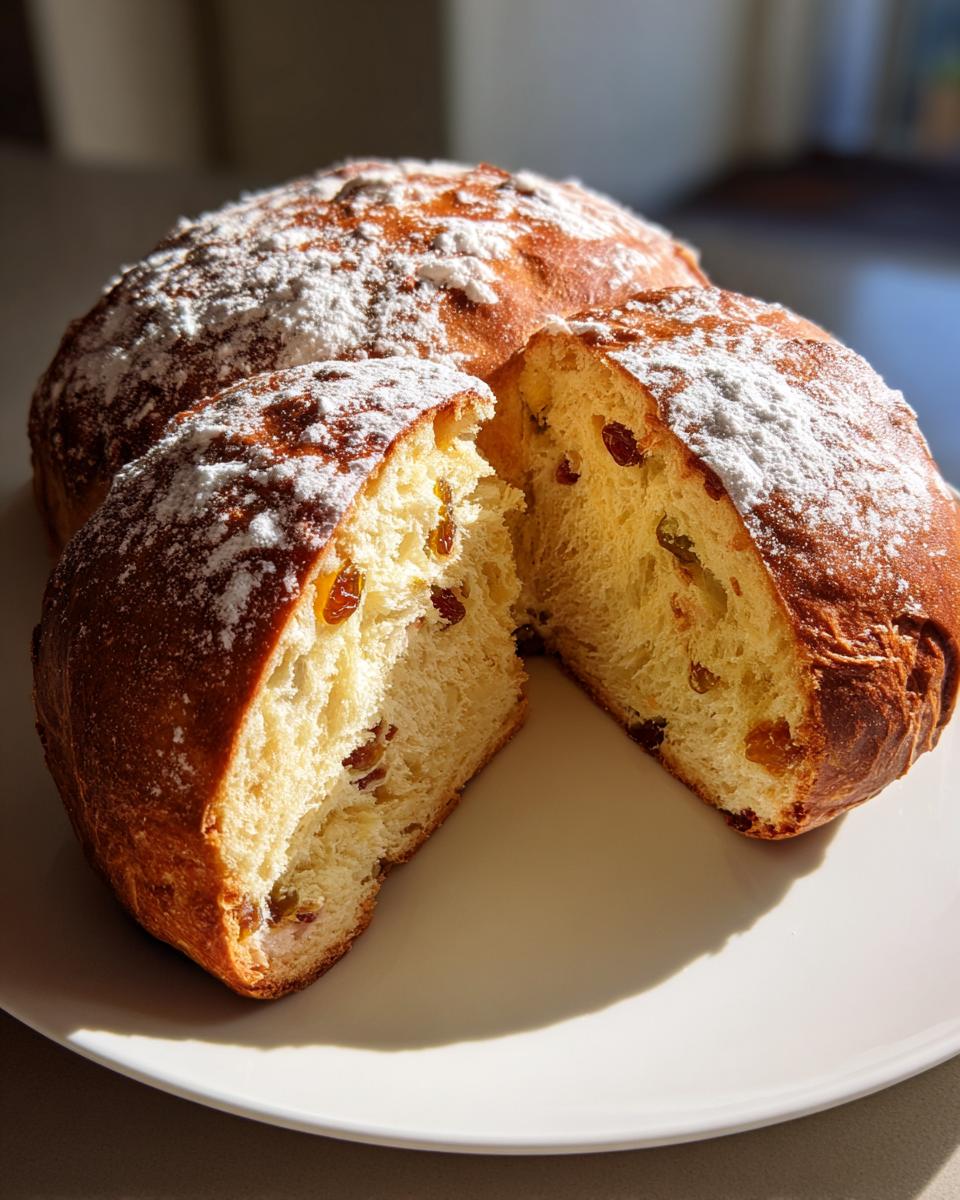
Decorating Your Stunning Ukrainian Paska Easter Bread
Now for the best part—making your Paska as beautiful as it is delicious! In my family, we’d gather around the table with bowls of icing and sprinkles, turning decorating into a joyful mess. Here’s how to make yours shine:
- Classic icing drizzle: Mix 1 cup powdered sugar with 2-3 tbsp milk or orange juice for a simple glaze. Drizzle artfully over the cooled loaf—the imperfect drips add charm!
- Symbols with meaning: Pipe crosses, braids, or sunbursts with thicker icing. These aren’t just pretty—they represent faith, eternity, and spring’s renewal.
- Edible confetti: Press colorful sprinkles or chopped nuts into wet icing for festive crunch. My niece loves arranging them in flower patterns.
- Candied citrus: Top with thin slices of candied orange or lemon for a fancy touch (and extra zing!).
Pro tip: Let the bread cool completely before decorating—unless you want your masterpiece to turn into a sugary landslide!
Serving and Storing Stunning Ukrainian Paska Easter Bread
Oh, the moment we’ve been waiting for—serving this beauty! For the full experience, slice your Stunning Ukrainian Paska Easter Bread while it’s still slightly warm (but not hot—patience, remember?). Spread a thick layer of softened butter or drizzle with honey, and watch it melt into those tender crumbs. At Easter brunch, we always serve it alongside hard-boiled eggs and ham, but it’s heavenly with just a cup of strong tea too.
To keep leftovers fresh (if you’re lucky enough to have any!), wrap cooled Paska tightly in plastic or store in an airtight container. It stays soft for 2-3 days at room temperature. For longer storage, slice and freeze in a zip-top bag—just pop a piece in the toaster to revive that fresh-baked magic. My grandma used to say day-old Paska makes the best French toast, and she wasn’t wrong!
Stunning Ukrainian Paska Easter Bread FAQs
Over the years, I’ve fielded dozens of Paska questions from friends and family—here are the ones that pop up most often, with my tried-and-true answers!
Can I skip the raisins in Paska?
Absolutely! While traditional, raisins aren’t mandatory. Swap in dried cranberries, chopped apricots, or even chocolate chips for a fun twist. Just be sure to soak any dried fruit first so they don’t steal moisture from your dough.
Why is my Paska dense instead of light and fluffy?
Three likely culprits: 1) Old yeast that didn’t activate properly (always do the foam test!), 2) The dough didn’t rise long enough (poke it—if the indent stays, it’s ready), or 3) You over-floured the dough during kneading. Next time, resist adding extra flour—a slightly sticky dough makes the lightest bread!
Can I make Paska ahead of time?
Yes! Prepare the dough through the first rise, then punch it down, wrap tightly, and refrigerate overnight. The next day, let it come to room temperature (about an hour) before shaping and doing the second rise. This slow fermentation actually deepens the flavor!
My Paska browned too quickly—is it ruined?
Not at all! If the top is getting too dark, tent it loosely with foil partway through baking. The inside will continue cooking while the crust takes a break from tanning. I’ve saved many loaves this way!
What if I don’t have a round pan?
No worries—Paska adapts! Use a loaf pan for a simpler shape, or get creative with free-form braids or knots on a baking sheet. The taste is what matters most. My aunt once baked hers in a cleaned flowerpot for a rustic look!
Nutritional Information
Just so you know, these numbers are estimates—your actual counts might dance a bit depending on your exact ingredients and slice size! For a 100g serving of this Stunning Ukrainian Paska Easter Bread, expect about:
- 320 calories – It’s celebratory bread, after all!
- 50g carbs – Mostly from that wholesome flour and touch of sugar
- 10g fat – Thank the butter for that rich texture
- 8g protein – Eggs and flour teaming up
Remember, holidays are for savoring—not counting every crumb!
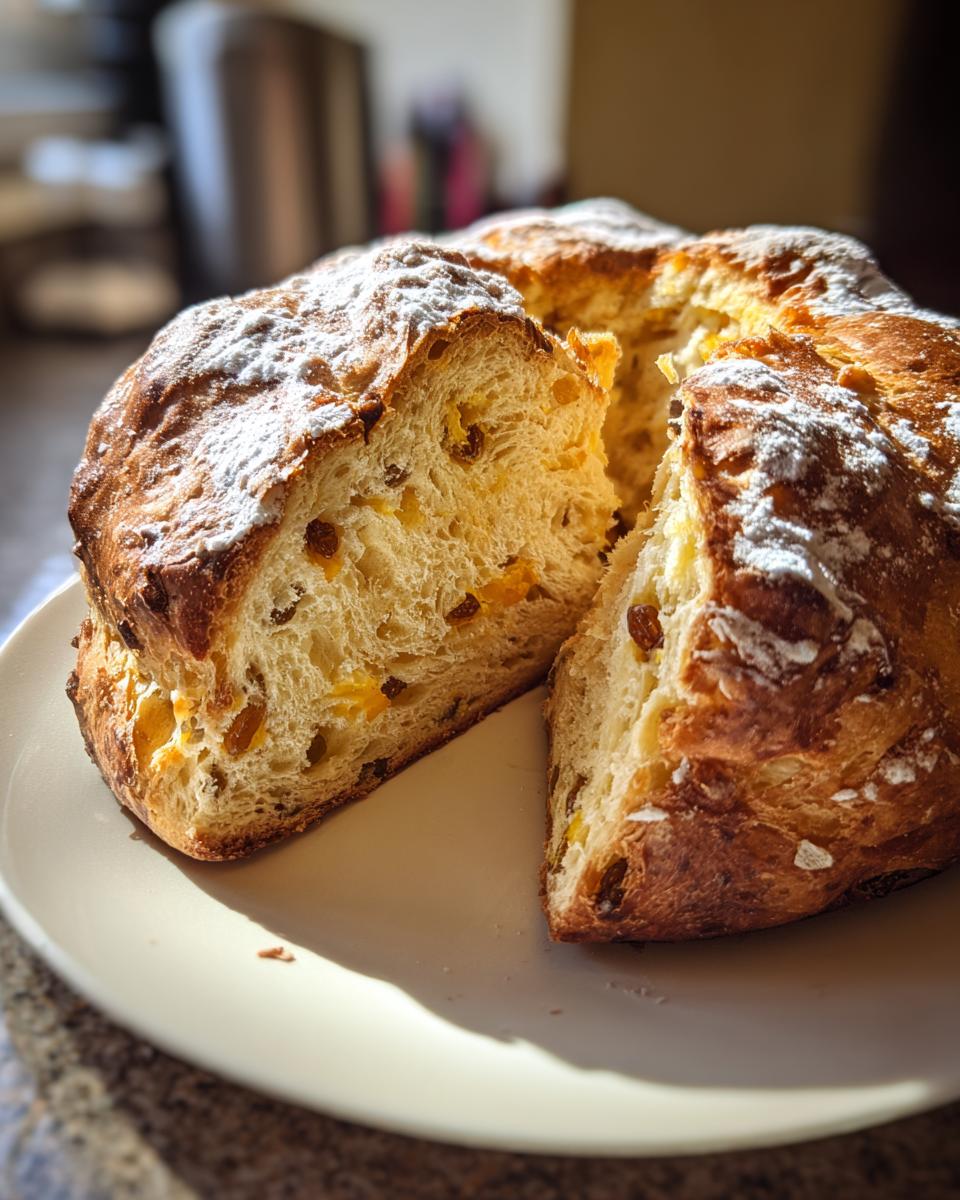
Share Your Stunning Ukrainian Paska Easter Bread
I’d LOVE to see your Paska creations! Snap a photo of your golden masterpiece and tag me—nothing makes me happier than seeing those braided crosses and icing swirls. Did you add a special twist? Leave a comment below with your tips! Let’s keep this delicious tradition alive together.
Print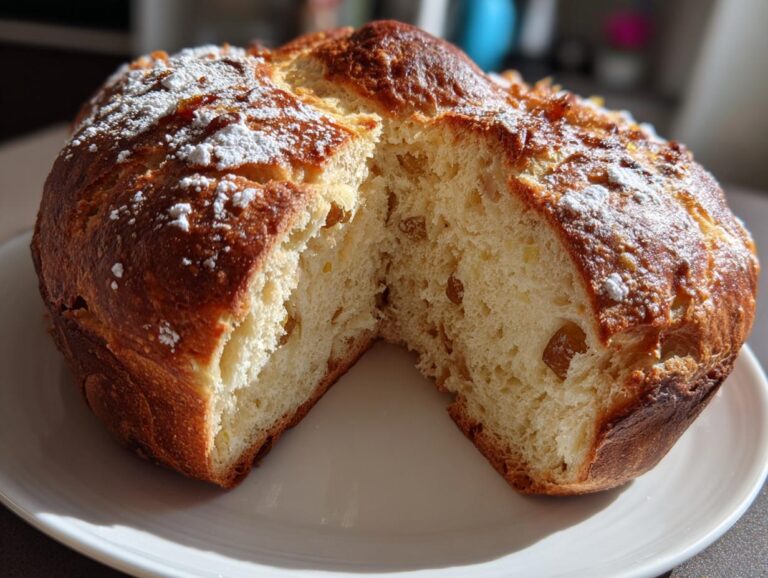
4 Golden Secrets to Stunning Ukrainian Paska Easter Bread
A traditional Ukrainian Easter bread, Paska is a rich, sweet, and beautifully decorated loaf. It’s a centerpiece of the Easter table, often flavored with raisins and citrus zest.
- Total Time: 3 hours 45 minutes
- Yield: 1 large loaf 1x
Ingredients
- 500g all-purpose flour
- 100g sugar
- 10g active dry yeast
- 250ml warm milk
- 3 eggs
- 100g butter, melted
- 1 tsp vanilla extract
- 1 tsp salt
- 100g raisins
- Zest of 1 lemon
- Zest of 1 orange
Instructions
- Dissolve yeast in warm milk with a pinch of sugar. Let sit for 10 minutes until frothy.
- Mix flour, sugar, and salt in a large bowl.
- Add yeast mixture, eggs, melted butter, vanilla, and citrus zest. Knead until smooth.
- Fold in raisins. Cover and let rise for 2 hours or until doubled.
- Shape dough into a round loaf. Place in a greased pan.
- Let rise for another hour.
- Bake at 180°C (350°F) for 40-45 minutes until golden.
- Cool before decorating with icing or traditional symbols.
Notes
- Use room temperature ingredients for best results.
- Knead dough well to develop gluten.
- Let dough rise in a warm, draft-free place.
- Decorate with icing, sprinkles, or nuts if desired.
- Prep Time: 3 hours
- Cook Time: 45 minutes
- Category: Bread
- Method: Baked
- Cuisine: Ukrainian
- Diet: Vegetarian
Nutrition
- Serving Size: 1 slice (100g)
- Calories: 320
- Sugar: 15g
- Sodium: 200mg
- Fat: 10g
- Saturated Fat: 6g
- Unsaturated Fat: 3g
- Trans Fat: 0g
- Carbohydrates: 50g
- Fiber: 2g
- Protein: 8g
- Cholesterol: 70mg

